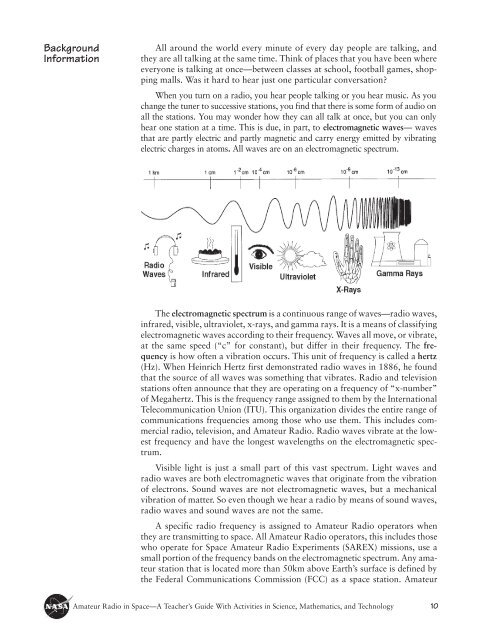Amateur Radio in Space - ER - NASA
Amateur Radio in Space - ER - NASA
Amateur Radio in Space - ER - NASA
- No tags were found...
You also want an ePaper? Increase the reach of your titles
YUMPU automatically turns print PDFs into web optimized ePapers that Google loves.
BackgroundInformationAll around the world every m<strong>in</strong>ute of every day people are talk<strong>in</strong>g, andthey are all talk<strong>in</strong>g at the same time. Th<strong>in</strong>k of places that you have been whereeveryone is talk<strong>in</strong>g at once—between classes at school, football games, shopp<strong>in</strong>gmalls. Was it hard to hear just one particular conversation?When you turn on a radio, you hear people talk<strong>in</strong>g or you hear music. As youchange the tuner to successive stations, you f<strong>in</strong>d that there is some form of audio onall the stations. You may wonder how they can all talk at once, but you can onlyhear one station at a time. This is due, <strong>in</strong> part, to electromagnetic waves— wavesthat are partly electric and partly magnetic and carry energy emitted by vibrat<strong>in</strong>gelectric charges <strong>in</strong> atoms. All waves are on an electromagnetic spectrum.The electromagnetic spectrum is a cont<strong>in</strong>uous range of waves—radio waves,<strong>in</strong>frared, visible, ultraviolet, x-rays, and gamma rays. It is a means of classify<strong>in</strong>gelectromagnetic waves accord<strong>in</strong>g to their frequency. Waves all move, or vibrate,at the same speed (“c” for constant), but differ <strong>in</strong> their frequency. The frequencyis how often a vibration occurs. This unit of frequency is called a hertz(Hz). When He<strong>in</strong>rich Hertz first demonstrated radio waves <strong>in</strong> 1886, he foundthat the source of all waves was someth<strong>in</strong>g that vibrates. <strong>Radio</strong> and televisionstations often announce that they are operat<strong>in</strong>g on a frequency of “x-number”of Megahertz. This is the frequency range assigned to them by the InternationalTelecommunication Union (ITU). This organization divides the entire range ofcommunications frequencies among those who use them. This <strong>in</strong>cludes commercialradio, television, and <strong>Amateur</strong> <strong>Radio</strong>. <strong>Radio</strong> waves vibrate at the lowestfrequency and have the longest wavelengths on the electromagnetic spectrum.Visible light is just a small part of this vast spectrum. Light waves andradio waves are both electromagnetic waves that orig<strong>in</strong>ate from the vibrationof electrons. Sound waves are not electromagnetic waves, but a mechanicalvibration of matter. So even though we hear a radio by means of sound waves,radio waves and sound waves are not the same.A specific radio frequency is assigned to <strong>Amateur</strong> <strong>Radio</strong> operators whenthey are transmitt<strong>in</strong>g to space. All <strong>Amateur</strong> <strong>Radio</strong> operators, this <strong>in</strong>cludes thosewho operate for <strong>Space</strong> <strong>Amateur</strong> <strong>Radio</strong> Experiments (SAREX) missions, use asmall portion of the frequency bands on the electromagnetic spectrum. Any amateurstation that is located more than 50km above Earth’s surface is def<strong>in</strong>ed bythe Federal Communications Commission (FCC) as a space station. <strong>Amateur</strong><strong>Amateur</strong> <strong>Radio</strong> <strong>in</strong> <strong>Space</strong>—A Teacher’s Guide With Activities <strong>in</strong> Science, Mathematics, and Technology 10
















